Promotion of applications in the AppStore (Google Play)
- Tutorial

Before we wrote this material, our applications were downloaded more than 2,000,000 times, we conducted about 50 large promotional campaigns, visited the AppStore tops in more than 24 countries, and finally put all this into one big work flow. The article has almost no obvious things about keywords, the beauty of icons, screenshots and advertising campaigns. We tried to bring the work of the food company to a single model by answering the questions: “what?”, “When?”, “Why?” And even to the question “and then what?”. If you are developing your own application, want to start doing it, or you just have a friend, developer or marketer of a food company - in this article you will find a lot of useful information.
Application Promotion Model
We divided the model of application promotion into several levels, following the example of the OSI network model.
- The basic level is the stage of product development, code writing and design creation.
- Key - the application is ready, the stage of placing the application in the AppStore, selecting keywords, screenshots, an icon, etc.
- Public - the application is already available for download by users or the exact release date of the product is known, working with journalists
- Advertising - the business itself, calculating profitability.
Below, each level will be considered separately. You will find a lot of useful material about the promotion of applications at http://Cool-Link.com

A basic level of
At the Basic level, many key decisions are made, but since we are considering only the marketing part here, we will not consider architecture and UX issues.
Everyone knows the common belief that marketing should begin long before the product enters the market, but few people understand the essence of this statement. Yes, preparing press releases, drawing a landing page and making a promotional video is, of course, important. At the same time, when developing a product, we are already thinking about promoting the next and increasing return to the current one. What is required for each of our products, what is added at the development stage?
- Push noti fi cations - every product must ask for permission to push notifications, even when the product’s functionality does not require it. To increase the conversion, some products use an intermediate screen (as on the slide). As a result, with the help of push notifications you can remind the user about your product or advertise a new one by overloading traffic. This has a number of advantages, which I will discuss later. To work with push, we use our own development and now we are moving to a very convenient service parse.com .
- Splash screen or banners - even if you have an advertising monetization model, it is highly recommended to add the ability to include your own banners or full-screen advertising. It must be controlled from the server, so you can remotely turn on / off advertising, as well as change the advertising art and links.
- Email Subscription - Email marketing is still a fairly effective promotion tool with a high conversion, and you never know who has signed up for the email newsletter. Perhaps this is a Washington Post journalist who will write an article about you. By the way, it was after the email newsletter that we met one of our best partners, the Appadvice site.
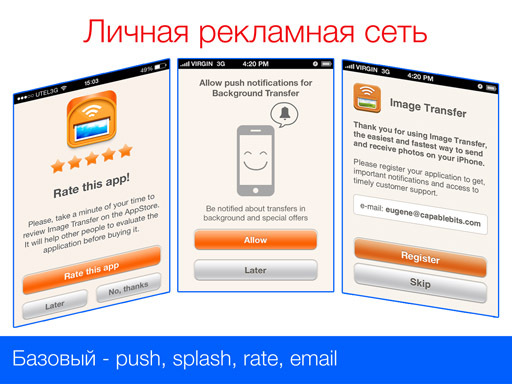
Thus, if you have a product or product package, when you release the next one, you can already get a lot of free traffic. And if you have a monobrand company - you can release a series of products that work to maintain the main one, but this is the topic of a separate article :)
Also, at the Basic level, pay special attention to analytics. It is impossible to talk about it in the framework of one article, so just short recommendations. For analytics, we recommend using Flurry , Google Analytics and Mixpanel (paid).

Key level
This is the level of iTunes Connect, i.e. the place where you create the face of the product. About how to choose the right icon, draw selling screenshots and choose keywords, a million articles were written and there were thousands of reports. You can easily find all this, and if you have been developing applications for a long time, then you already have enough of it.
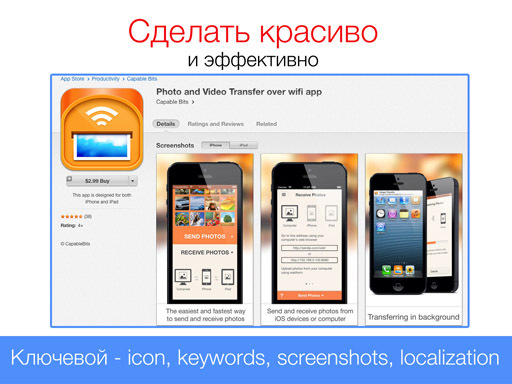
Here are some not-so-obvious tips:
- texts are better read if they are at the top of the screenshot (yes, for now we have the other way around :)) - keywords can and should be entered one at a time, separated by commas, without spaces;
- above are quoted keywords that were able to be placed in the name, but not the whole name is fully indexed by a search in the AppStore, about the first 100 characters;
- old but relevant article about keywords HERE
- good presentation about keywords:
Also, at the Key level, you can use such a method of increasing downloads as lowering the price. If you put the cost of the application, say, $ 4, and then reset it to zero, then the number of downloads will increase: on different products, this figure ranges from 1000 free downloads to 80,000. When you return the price back, you get a short tail of sales. Of course, this cannot be called a business model, but if you provided for in your products what we talked about at the Basic level, then this is not just a few thousand downloads and a couple of dollars, but a couple of thousand push devices and a couple of hundred new email subscribers. In the future, they will be able to bring you more than just selling the current product.

Public level
Everything here is more or less simple - it’s cool when big publications write about you, you get a lot of downloads, don’t pay money for it and just amuse yourself with pride. Yes, get acquainted with the press in advance, give them access to the beta version of the product through TestFlight or other services, ask for advice and so on, but there is one “but”. Do not spend a lot of time on this. If you have good relations with the press - excellent, they will write about you, if you have a cool product - excellent, they will write about you, just let them know. Journalists read almost all correspondence, this is their work, but articles in large publications should not be an end in itself, it should be a nice bonus. And if it is not there, then it’s okay. It is impossible to build a business that will rely solely on the love of the press, but if it subsequently arises and it works for you, it’s wonderful.
The largest Western blogs and almost all the resources of the uanet and runet wrote about our Wallgram application. And here is the sales schedule:
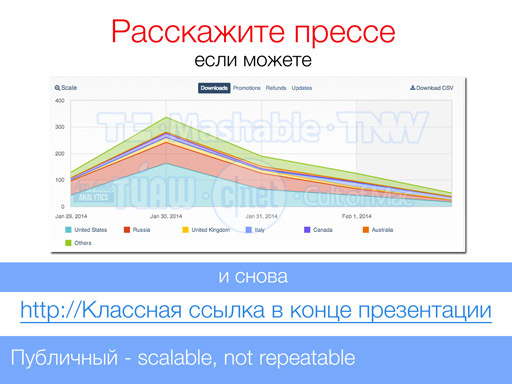
This is a schedule with no advertising feeds and only a paid version. You can easily see how sales fell the day after the main publications.
A list of the main sites to which you can send a press release is HERE . On the main site Cool-Link.com you will also find this link and many others
Advertising level
It is at this level that business begins. Here, absolutely everything that you did at the previous levels will come in handy, and everything that you have not done will play against you. Advertising.
Application development is not an online plush toy store, so the classic ROI formula is unlikely to work here, since the cost of the current version of the product is static and its share is constantly decreasing with increasing sales. So for the advertising campaign, we chose the formula for calculating the efficiency - efficiency coefficient, well-known from the physics course. The whole charm of application development is that in the real world the efficiency cannot be more than 1, but in the AppStore it can and should be more.
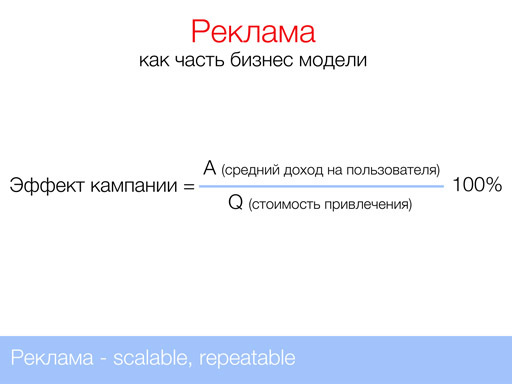
It is logical that in order to increase the efficiency of an advertising campaign you need to work on increasing the average income from the user and reducing the cost of attracting him.
So A is the average income from the user:

“A” is calculated as the ratio of profit for the period to the number of all users. Those. if the application, conditionally, brought $ 10,000 per month, and 100,000 people downloaded it, then A = 10,000/100,000 = $ 0.1 or 10 cents. Returning to the previous formula, for the business model to work, it is necessary that the user engagement be LESS than 10 cents, which is unlikely, so you need to increase A.
- Increased conversion - at the Basic level, we added analytics and immediately begin to count the funnels - the sequence of user actions, after which he begins to pay or perform the desired action. And then - individually for each product - if we see that 40% of users see the purchase screen, but only 3% make a purchase, change the wording, pictures, and so on - here are the panaceas, alas, no.
- Safe price increase. It is logical that if 100 people paid us a dollar, then we earned $ 100, and if we increase the price to two dollars, then we will pay less people, for example, 70, but these 70 will bring us $ 140, which is $ 40 more than the original $ 100. But if, after doubling the price, only 30 users started paying ($ 60 dollars profit in the same example), then this price is no longer effective.
- Change the business model. Users may not be willing to pay for what you sell, but they are willing to pay for what you give for free. Once again, analytics enters the scene, where you can clearly see what your users need.
- Change of wording - this item also refers to the analysis of funnels, but it is taken out separately, since perhaps you need to add a psychological technique. For example, in our Image Transfer application, there were only two points on the purchase screen - Buy the full version for $ 2.99 or use a product with a restriction. The conversion was very low. After we added “Additional features”, such as “Remove restrictions on photos for $ 2.99”, “Remove restrictions on videos for $ 1.99” or “Remove ALL restrictions on $ 2.99”, i.e. Obviously, removing all restrictions is much more profitable. At the same time, there are always users who remove the restriction on the video, and then, separately, remove the restrictions on the photo, thus paying $ 4 instead of $ 3 for the product. There were even two users who later separately purchased a paid version of the product :)
- Localization. English, of course, is an international language, but not everyone knows it, which can provide low conversion. If you see that you have a lot of downloads, for example, in France and at the same time a low conversion, it might be worth considering localization into French.
Example wording change:
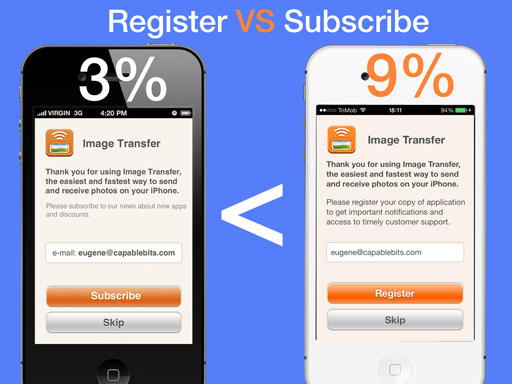
By and large, here you need to work exclusively with conversion, since you can’t reduce N - the number of users, they have already downloaded your product.
Decrease in Q - cost of attracting users.
It’s not enough just to choose an ad network in which users will cost you the least, as different traffic sources have different conversions. So, in one ad network a user can cost you 10 cents, but the average profit from this cohort will be 5 cents, i.e. Efficiency = 0.5, and in the other it will cost $ 1, but the average cohort will bring $ 1.2, i.e. Efficiency = 1.2.

How can the Q decrease be affected:
- Creating your own promotion channels. What you had to do at the Basic level: push notifications, advertising of a new product in the previous ones, email distribution - all this reduces the cost of Q, because this traffic can be considered shareware, or you have already paid for it. Also in new products you can convert users who did not pay you in the previous one. You can create satellites - small products designed exclusively for generating traffic.
- Increase your advertising budget. Indeed, increasing the advertising budget, you increase the number of downloads, and increasing the number of downloads, you rise higher in the search results for keywords and even get into the general TOPs. Once in the general tops and increasing your position in search results, you increase the number of organic ones, i.e. free downloads, which means you reduce Q. So, you paid the ad network, for example, $ 10,000 for 10,000 users, that is, the cost of the user was $ 1, but thanks to organic traffic, you got 15,000 downloads, that is, the cost The user is already $ 0.6.
- Choosing the best channel to attract. Everything is simple here - abandon the channels of attraction with low efficiency, everything here is very similar to ROI.
- Partnership with other developers. If your colleagues have also provided a Baseline, they will agree to advertise in their products. Sometimes this can significantly reduce the cost of attraction.
- Gradual increase in advertising budget - crescendo. Since the App Store uses the weighted average number of downloads for the period, the most effective advertising campaigns are developing in increasing order - the first day of 3K downloads, the next 5K, the next 10K and so on, and not immediately in one day 15K, so you have a chance to get into TOPs and save through organic traffic.
- Journalists Yes, if you did manage to negotiate with the press, this is a great way to reduce the cost of users, as journalists provide you with leads for free.
Of course, the presented model is not a panacea, a lot depends on the product itself, its release time, relevance, vacuum, etc., but all this is vitally important if you want to build a business on this.
It is important to understand that the advertising model for premium products, i.e. paid, does not work in its pure form. Attracting a user will always cost more than he will pay for a paid product. And at the same time, there is always the opportunity to offset costs through organic downloads. You can use the fremium model even in a paid product. At the moment, we consider the most effective model a subscription, i.e. the user pays you all the time using the product, thanks to this business model you can afford a much higher user cost, because and the profit from it at a distance will be much greater.
Even if the advertising model for your products does not work, the previous levels of promotion still remain working. In almost all of our products, we use both models - freemium and premium. So, our Photo and Video Transfer is a paid application without any restrictions, and Image Transfer is a completely identical application, but free, however, it has built-in purchases, at the moment the income from both models is about the same.
Now that we’ve figured out the theory of application promotion a bit, it's time to return to Cool-Link.com , read a few more articles from the industry’s gurus and get started.
O capablebits
CapableBits has been developing its own applications for over 4 years. In early 2014, we opened the direction of publishing mobile applications - if you have a product or it is under development and you want it to start making money, send us a request to publisher@capablebits.com . More information on our website CapableBits.com
